
 |
San Antonio Spurs (ABA)2012 NBA/ABA Throwback Uniforms -
|
Back to "Remember the ABA" Main Page
Did you see an ABA Spurs game? Or, did you have a favorite ABA Spurs player? Contribute to this web page by
In the spring of 1973, the Dallas Chaparrals had reached the end of the line. The wealthy Dallas owners had consistently refused to spend money on the team, dooming it to yearly mediocrity. Attendance was almost nonexistent. While one of the Dallas owners wanted to continue operations in Dallas, the rest of the owners wanted out. A small group of San Antonio investors was aware of the situation in Dallas, and took action.
With Angelo Drossos, B.J. "Red" McCombs (current majority owner of the NFL Minnesota Vikings), and John Schaefer leading the way, a group of 36 San Antonio citizens were assembled and convinced that this would be San Antonio's chance to get a professional sports team. The San Antonio investors worked out a unique arrangement with the Dallas owners. It was a "lend-lease" type of formula. The San Antonio people would operate the team in San Antonio for three years, with an option to buy following the three-year period. If no sale occurred after three years, the team would revert back to Dallas.
The San Antonio group first named its team the San Antonio "Gunslingers," but then changed the name to the "Spurs." Tom Nissalke was hired to coach the team. Nissalke had coached the Chaparrals during the 1971-72 season, and had resigned at the end of that season, even after winning ABA Coach of the Year honors. When he took the Spurs job, Nissalke said: "It's not often in sports that you get to rectify an error in judgment. I realize in retrospect I should have stayed in Dallas and continued building and working with that club. Things had really fallen in place there. I feel fortunate to have the challenge again."
The Spurs' first season (1973-74) was a memorable one. In October 1973, San Antonio's starting lineup consisted of 5-10 Joe Hamilton, 6-3 James Silas, 6-3 Harley "Skeeter" Swift, 6-8 Rich Jones, and 6-9 Bob Netolicky. While this lineup didn't stay together very long, it treated San Antonio's new fans to a 91-89 exhibition season victory over the NBA Houston Rockets on October 6, 1973.
| Here are some original San Antonio Spurs. At left is the Spurs' first coach, Tom Nissalke. Nissalke brought a patterned, deliberate offense to San Antonio. The three players are (from left to right) Harley "Skeeter" Swift, Joe Hamilton, and Bob Netolicky. All three of these men were in the very first San Antonio starting lineup on October 10, 1973 against San Diego. But, none of these players stayed with the Spurs very long. Swift was released, Hamilton was traded to Kentucky, and Netolicky was traded to Indiana. In these photos, the players are wearing their 1973 pre-season Spurs "red" jerseys. (ABA publicity photos courtesy of Jon Singer) | |||
On October 10, 1973, in their home opener against the San Diego Conquistadors, the Spurs lost but attracted over 6,000 noisy fans to HemisFair Arena. This prompted guard Joe Hamilton to say: "It's just great to play for these people. They're rooting for us all the time. Last year at Dallas we'd have 600 or 700 people at our games, and if we got something going, maybe a dozen of them would start yelling. The rest of them just sat there." Over the course of the season, San Antonio's gaudy attendance figures surprised the entire league. In only 18 home games, the Spurs managed to draw more fans than the Chaparrals had during their entire 42-game home schedule in 1972-73. The Spurs ended up averaging 6,303 fans per game. ABA fans enjoyed pointing out that this figure far surpassed the 1973-74 average attendance of the nearby NBA Houston Rockets, whose top crowd that season barely exceeded 6,000. In fact, the Spurs' first-year attendance was so impressive that Drossos and the other San Antonio owners decided to "take the plunge." They canceled their three-year lease of the team, and bought the franchise outright from the Dallas owners.
The 1973-74 Spurs were controlled and deliberate on offense, and extremely stingy on defense. This became apparent early in the season on October 20th, when the Spurs beat the Indiana Pacers 92-66. The 66-point output by Indiana was an ABA record low. Two weeks later, on November 3rd, the Spurs limited the Denver Rockets to 72 points. Over the course of that first season, the Spurs held their opponents below the 100-point level 49 times -- another ABA record.
During that first season, several off-court events changed the course of Spurs' history.
First, on November 21, 1973, the Spurs acquired rookie center Swen Nater from the cash-starved Virginia Squires. Earl Foreman, the Squires' owner, accepted $300,000 and a future draft pick for Nater. Nater fit right into the Spurs' lineup and provided a huge lift under the boards. He made the West All-Star team that year, scoring 29 points and grabbing 22 rebounds in the 1974 ABA All-Star Game (played, ironically, in Norfolk Virginia). He was also the consensus winner of the ABA Rookie of the Year award.
Second, ABA Commissioner Storen upheld the Spurs' protest of a home loss to Indiana on November 14. This ruling grabbed the attention of all the basketball fans in San Antonio. On December 2, 1973, Spurs fans went wild over a special basketball "doubleheader" at the HemisFair Arena. The December 1973 ABA Fan Club Newsletter described it this way:
| "A wildly screaming crowd of more than 9,000 saw San Antonio and Indiana split their 'doubleheader' December 2 in San Antonio, as the home team won the opener in overtime and Indiana came from 19 points behind to grab the regularly scheduled contest. The opener, of course, was a replay of the final 30 seconds of a protested game of November 14. Commissioner Storen's ruling took the winning three-point field goal away from Indiana and San Antonio was given the ball with an 83-81 lead and 30 seconds to play. The crowd gave the Spurs a standing ovation as the teams took the court. Then with 8 seconds left, Bob Netolicky (now playing for Indiana after being traded by San Antonio before the November 14 game) stole an inbounds pass for the Pacers. George McGinnis was then fouled as time ran out and, after missing the first free throw, hit the next two to send the game into overtime. San Antonio finally broke an 89-89 tie on a jumper by Rich Jones with 1:42 left to play. The jumper to put the Spurs ahead to stay. The Spurs held a 45-26 lead in the second game, but Indiana pulled away with a league record 18 straight points during a 7 minute, 37 second span at the end of the third quarter and beginning of the fourth." |
The third significant event that season was San Antonio's acquisition of its all-time best player, George "Ice" Gervin, from the Squires. In January, Earl Foreman was once again in need of cash to run his Virginia franchise. Having already purchased Nater from Foreman in November, Spurs Treasurer Angelo Drossos was interested in acquiring another star player. Drossos offered to loan $225,000 to Foreman, with Gervin as the collateral. If Foreman failed to pay off the $225,000 by February, Gervin would belong to San Antonio. Naturally, Foreman failed to repay the $225,000, and Gervin's contract became the property of the Spurs.
When ABA Commissioner Storen found out about the Gervin deal, he tried to rescind it. Storen claimed that the deal was "detrimental to the league, and to the financial viability of the Virginia Squires franchise." The matter went before District Court Judge Adrian Spears, in San Antonio. In court, the Spurs produced canceled checks for $225,000, made out to Foreman, to prove that the deal was valid. Judge Spears agreed and issued an order preventing Gervin from playing for any other ABA team than the Spurs. Gervin played his first game with the Spurs on February 7, 1974 against the Utah Stars, and scored 12 points. He proceeded to play ten more seasons for San Antonio, and became the symbol of San Antonio Spurs basketball. Recently, he was inducted into the Basketball Hall of Fame.
With Gervin, Nater, and Silas leading the way, the Spurs won 45 games that year, and faced Indiana in the playoffs. The series went back and forth. Indiana eventually won the series in seven games. But the Spurs drew the largest home crowd in their brief history (12,304) for Game 6 on April 10, 1974. Along with a rousing victory over the Pacers, Spurs fans were treated to a halftime "sermonette" by evangelist Bob Harrington. Apparently, Harrington had booked HemisFair Arena for the date of Game 6. Harrington agreed to let the Spurs play that day, but only if he was allowed to preach to the crowd at halftime. "It's halftime in the game of life, and the clock is running out!" Harrington screamed at intermission. "I was told to give 'em hell, but I just want to give you heaven!" Harrington's crusade included a 300-voice choir. The choir sang the National Anthem, and also led hymn signing as Spurs fans filed out of HemisFair after the game. The Spurs attracted 10,693 and 12,079 for their other two home games in the series (cramming the 10,146-seat arena).
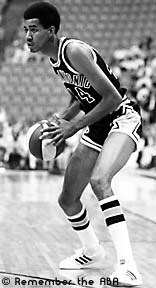 |
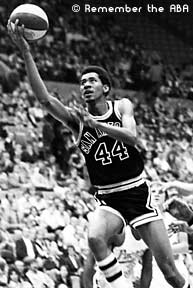 |
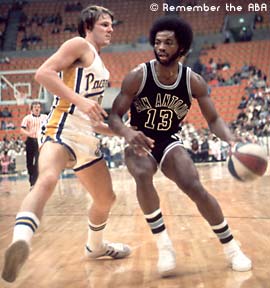 |
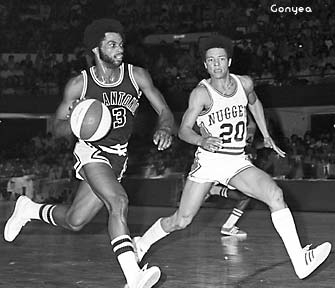 |
These two players, George Gervin (#44, above left and above middle) and James Silas (#13, above right and left), were the core of the team during its ABA days. Angelo Drossos bought Gervin from the cash-strapped Virginia Squires in the middle of the Spurs' first season, 1973-74. The young Gervin, also known as "Ice," became a scoring machine, averaging a consistent 23.4 points per game during each of his first two years with the team. Known for his trademark "finger-roll" shot (shown above), Gervin went on to have a long and productive NBA career, and was inducted into the Basketball Hall of Fame in 1997.
Silas was an original ABA Spur, and played for San Antonio for eight straight seasons. Silas was considered one of the quickest, strongest guards in the ABA. His nickname was "Captain Late" because he was a fourth quarter clutch performer. At the time, Spurs' coach Bob Bass said that: "Si is a fourth quarter player. In the final minutes, he gets tougher than the back end of a shooting gallery." When a Spurs game came down to last minute pressure, the moment usually belonged to Silas. |
For the 1974-75 season, the Spurs acquired high-scoring guard Donnie Freeman from Indiana, and also traded away Bird Averitt. Spurs fans had high expectations for their team, as San Antonio was a perfect 8-0 in the exhibition season. The team got off to a 17-10 start in the regular season. At that point, however, the Spurs' owners (Drossos in particular) had become disenchanted with the coaching style of Tom Nissalke. Nissalke's Spurs played a slow-down type of offense, and the Spurs' owners wanted a run-and-gun team. On his part, Nissalke was irritated that the Spurs owners had passed up golden opportunities to acquire Gene Littles, George Carter, Stew Johnson, and Terry Driscoll. So Nissalke was replaced by longtime ABA coach Bob Bass. Bass immediately stated that the Spurs would have an entirely new playing style: "It is my belief that you cannot throw a set offense at another professional team for 48 minutes. You've got to let them play some schoolyard basketball."
The Spurs, especially Gervin and Silas, took Bass' philosophy to heart. They became an entertaining, fast-breaking team that was fun to watch. On January 17, 1975 the Spirits of St. Louis outrebounded the Spurs 61-32 (31-6 on the offensive boards), but the Spurs still won the game 138-120. How was that possible? The quick-shooting Spurs made 60% of their shots during that game (and made a sizzling 71% in the second half). On January 28, 1975, the ABA All-Star Game came to HemisFair Arena, and drew 10,449 loud fans. Gervin and Nater started for the ABA's West team, scoring 23 points and 12 points, respectively. Silas came off the All-Star bench to score 21 points. On February 5, 1975, Gervin scored 51 points against the Memphis Sounds (0 points in the 1st quarter, 25 in the 2nd, 8 in the 3rd, and 18 in the 4th), using a variety of jump shots, dunks, and fingerrolls. Also, on February 8, 1975, the Spurs went into Denver's Auditorium Arena and beat the Denver Nuggets 120-115, breaking Denver's ABA-record 26-game home winning streak. San Antonio fans, enjoying the Spurs' new style of play, came to home games in droves. Attendance went up 25% from the year before, to 7,853 per game. In the playoffs, the Spurs played Indiana again in the first round. This time, the Spurs had the home court advantage. But the Pacers, behind George McGinnis, took a 3-0 lead in the series. The Pacers ended up holding off the Spurs 4 games to 2.
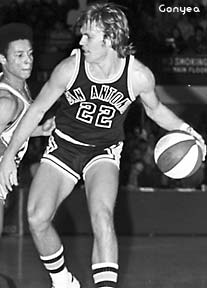 |
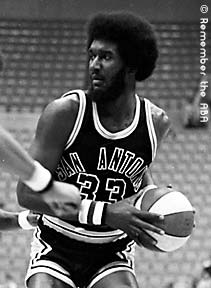 |
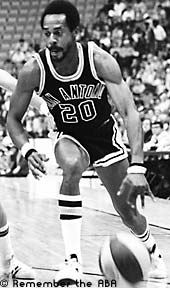 |
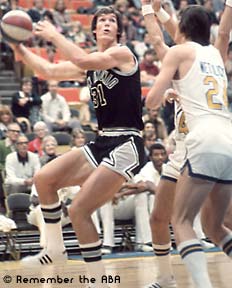 |
Some fondly-remembered players from the Spurs' ABA days:
Feisty George Karl (above left) was signed out of North Carolina and played for the Spurs in each of their ABA years. His best year was the 1974-75 season, in which he averaged 8.1 points, 4.1 assists, and 1.1 steals per game. And look at all the hair! Of course, Karl is more famous now as the head coach of the Milwaukee Bucks. Rich "House" Jones (#33, above middle) was a holdover from the old Dallas Chaparrals, providing rebounding, steals, and hustle. Donnie Freeman (#20, above right) was acquired from the Pacers for the 1974-75 season. He proved to be a significant scoring threat alongside George Gervin, averaging 15.5 points per game. Freeman was recently voted one of the top 30 All-Time ABA Players. On November 21, 1973, the Spurs obtained rookie center Swen Nater (#31, left) from the Virginia Squires. In his college days at UCLA, the 6-11 Nater did not attract much notice as the backup for All-America center Bill Walton. As a starter for the Spurs, however, Nater flourished. He was named the ABA Rookie of the Year (and second team All-ABA) for the 1973-74 season. In 1974-75, Nater beat out Artis Gilmore and Marvin Barnes for the ABA rebounding title (with a 16.4 rpg average) and was again named second team All-ABA. |
Before the ABA's last season, 1975-76, the Spurs made some significant personnel changes that helped the team for years to come. Two blockbuster trades were made with the New York Nets. Rich Jones, Chuck Terry, Bobby Warren, and Kim Hughes went from San Antonio to New York. San Antonio got Billy (the "Whopper") Paultz, Larry Kenon, and Mike Gale in return. Allen Bristow, a 6-7 forward, signed with San Antonio after playing with the NBA Philadelphia 76ers. Also, when the San Diego Sails folded in November, the Spurs acquired rookie forward Mark Olberding.
These new players gave the Spurs some much needed depth, allowed Gervin to switch to the guard position, and propelled the team to a 50-win season. Paultz, in particular, shored up the Spurs' defense and set a new team record for blocked shots in a season, with 253 (3.05 per game). On December 13, 1975, the Spurs blocked 21 shots in one game, setting a new ABA record.
On March 24, 1976 the Spurs went into McNichols Arena and beat Denver 135-122, snapping the Nuggets' 26-game home winning streak. In fact, it was the second straight year that the Spurs had broken a 26-game home winning streak by Denver. Because the Spurs kept breaking Denver's home winning streaks, and because of several on-court fights between the teams during the 1974-75 season, a strong rivalry developed between the Nuggets and the Spurs. Nuggets' coach Larry Brown called the Spurs a "dirty team" and yelled at George Gervin during a 1976 Denver loss at HemisFair Arena. Bob Bass got up from the Spurs bench, told Brown to shut up, and offered to fight him. After the game, the Nuggets' boss said "I don't like anything about San Antonio, their coaching staff, their franchise or their city. The only thing I like about San Antonio is guacamole salad." Naturally, the Spurs' rowdy group of fans, the "Baseline Bums," caught wind of Brown's quote. The next time the Nuggets visited HemisFair Arena, the Baseline Bums were ready. Nuggets' forward Gus Gerard remembers that: "The next time we came down there the people were throwing avocados out on the floor and dumping guacamole salad on the players. When Larry (Brown) went to the locker room, they had something like dime beer night that night, so they were pouring beer over Larry's head. That was pretty wild."
The Spurs' home attendance in 1975-76 increased again, to over 8,000 fans per game (easily topping the Houston Rockets' attendance figures for the third straight year). At the end of the season, San Antonio finished in third place, behind the New York Nets and the Denver Nuggets. But many ABA observers regarded San Antonio as the best, and most talented, team in the league. Nobody wanted to play the Spurs in the playoffs.
The New York Nets drew the Spurs in the first round. After the teams split the first two games of the series, it appeared as if the Spurs would eliminate the Nets. However, in Game 1 of the series, Spurs' guard James Silas had broken his ankle. This made the difference in a very close, hard-fought series, and the Nets barely prevailed in seven games. Many ABA observers felt that with a healthy Silas, San Antonio would have almost certainly advanced to face the Denver Nuggets for the ABA championship.
Given their rabid fan support (the HemisFair Arena was known throughout the league as the home of the "Noisiest Fans in the ABA"), the Spurs were attractive to the NBA at the time of the merger. San Antonio joined Denver, Indiana and New York as the only ABA teams to survive the merger. In their first NBA season (1976-77), the Spurs showed their depth and talent by winning 44 games and making the 1977 NBA Playoffs.
Spurs 1973 Preseason Home Uniform |
Spurs 1973 Preseason Road Uniform |
 Spurs 1973-76 Home Uniform |
Spurs 1973-76 Road Uniform |
1973-74 Season
Record: 45-39, Third Place in Western Division
1974 Playoff Results:Western Division Semifinals vs. Indiana Pacers (46-38)
Pacers won series, 4-3
Record: 51-33, Second Place in Western Division
1975 Playoff Results:Western Division Semifinals vs. Indiana Pacers (45-39)
Pacers won series, 4-2
Record: 50-34, Third Place
1976 Playoff Results:Semifinals vs. New York Nets (55-29)
Nets won series, 4-3
Record: 44-38, Third Place in Central Division
1977 Playoff Results:Eastern Conference Mini-Series vs. Boston Celtics (44-38)
Celtics won series, 2-0